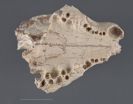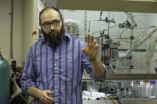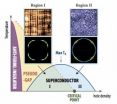(Press-News.org) CHAMPAIGN, Ill. — Looking at a smooth sheet of plastic in one University of Illinois laboratory, no one would guess that an impact had recently blasted a hole through it.
Illinois researchers have developed materials that not only heal, but regenerate. Until now, self-repairing materials could only bond tiny microscopic cracks. The new regenerating materials fill in large cracks and holes by regrowing material.
Led by professor Scott White, the research team comprises professors Jeffry S. Moore and Nancy Sottos and graduate students Brett Krull, Windy Santa Cruz and Ryan Gergely. They report their work in the May 9 issue of the journal Science.
"We have demonstrated repair of a nonliving, synthetic materials system in a way that is reminiscent of repair-by-regrowth as seen in some living systems," said Moore, a professor of chemistry.
Such self-repair capabilities would be a boon not only for commercial
goods – imagine a mangled car bumper that repairs itself within minutes of an accident – but also for parts and products that are difficult to replace or repair, such as those used in aerospace applications.
The regenerating capabilities build on the team's previous work in developing vascular materials. Using specially formulated fibers that disintegrate, the researchers can create materials with networks of capillaries inspired by biological circulatory systems.
"Vascular delivery lets us deliver a large volume of healing agents – which, in turn, enables restoration of large damage zones," said Sottos, a professor of materials science and engineering. "The vascular approach also enables multiple restorations if the material is damaged more than once."
For regenerating materials, two adjoining, parallel capillaries are filled with regenerative chemicals that flow out when damage occurs. The two liquids mix to form a gel, which spans the gap caused by damage, filling in cracks and holes. Then the gel hardens into a strong polymer, restoring the plastic's mechanical strength.
"We have to battle a lot of extrinsic factors for regeneration, including gravity," said study leader White, a professor of aerospace engineering. "The reactive liquids we use form a gel fairly quickly, so that as it's released it starts to harden immediately. If it didn't, the liquids would just pour out of the damaged area and you'd essentially bleed out. Because it forms a gel, it supports and retains the fluids. Since it's not a structural material yet, we can continue the regrowth process by pumping more fluid into the hole."
See a video at http://youtu.be/Rb5v-Hs6800.
The team demonstrated their regenerating system on the two biggest classes of commercial plastics: thermoplastics and thermosets. The researchers can tune the chemical reactions to control the speed of the gel formation or the speed of the hardening, depending on the kind of damage. For example, a bullet impact might cause a radiating series of cracks as well as a central hole, so the gel reaction could be slowed to allow the chemicals to seep into the cracks before hardening.
The researchers envision commercial plastics and polymers with vascular networks filled with regenerative agents ready to be deployed whenever damage occurs, much like biological healing. Their previous work established ease of manufacturing, so now they are working to optimize the regenerative chemical systems for different types of materials.
"For the first time, we've shown that you can regenerate lost material in a structural polymer. That's the kicker here," White said, "Prior to this work, if you cut off a piece of material, it's gone. Now we've shown that the material can actually regrow."
Moore, Sottos and White also are affiliated with the Beckman Institute for Advanced Science and Technology at the U. of I. The Air Force Office of Scientific Research supported this work.
INFORMATION:
Editor's note: To reach Scott R. White, call 217-333-1077; email swhite@illinois.edu.
The paper, "Restoration of Large Damage Volumes in Polymers," is available from scipak@aaas.org.
Downloadable high-resolution images with cutlines are available at https://uofi.box.com/regeneratingplastic.
Regenerating plastic grows back after damage
2014-05-08
ELSE PRESS RELEASES FROM THIS DATE:
Extinct kitten-sized hunter discovered
2014-05-08
A Case Western Reserve University student and his mentor have discovered an ancient kitten-sized predator that lived in Bolivia about 13 million years ago—one of the smallest species reported in the extinct order Sparassodonta.
Third-year undergraduate student Russell Engelman and Case Western Reserve anatomy professor Darin Croft made the finding by analyzing a partial skull that had been in a University of Florida collection more than three decades.
The researchers report their finding in the Journal of Vertebrate Paleontology online at: http://www.tandfonline.com/doi/full/10.1080/02724634.2013.827118#.U2p8-S8njhM.
"The ...
Fueling aviation with hardwoods
2014-05-08
A key challenge in the biofuels landscape is to get more advanced biofuels—fuels other than corn ethanol and vegetable oil-based biodiesel—into the transportation pool. Utilization of advanced biofuels is stipulated by the Energy Independence and Security Act; however, current production levels lag behind proposed targets. Additionally, certain transportation sectors, such as aviation, are likely to continue to require liquid hydrocarbon fuels in the long term even as light duty transportation shifts to alternative power sources. A multi-university team lead by George ...
Chemotherapy timing is key to success
2014-05-08
CAMBRIDGE, Mass-- MIT researchers have devised a novel cancer treatment that destroys tumor cells by first disarming their defenses, then hitting them with a lethal dose of DNA damage.
In studies with mice, the research team showed that this one-two punch, which relies on a nanoparticle that carries two drugs and releases them at different times, dramatically shrinks lung and breast tumors. The MIT team, led by Michael Yaffe, the David H. Koch Professor in Science, and Paula Hammond, the David H. Koch Professor in Engineering, describe the findings in the May 8 online ...
Climate change may worsen summertime ozone pollution
2014-05-08
Ozone pollution across the continental United States will become far more difficult to keep in check as temperatures rise, according to new research results.
The study shows that Americans face the risk of a 70 percent increase in unhealthy summertime ozone levels by 2050.
The results appear online this week in a paper in the Journal of Geophysical Research-Atmospheres, published by the American Geophysical Union.
The work was funded by the National Science Foundation (NSF) and the U.S. Department of Energy.
Warmer temperatures and other changes in the atmosphere ...
Scientists find solution to 2 long-standing mysteries of cuprate superconductivity
2014-05-08
UPTON, NY—Scientists seeking to understand the intricacies of high-temperature superconductivity—the ability of certain materials to carry electrical current with no energy loss—have been particularly puzzled by a mysterious phase that emerges as charge carriers are added that appears to compete with superconductivity. It's also been a mystery why, within this "pseudogap" phase, the movement of superconducting electrons appears to be restricted to certain directions. So exploring the pseudogap and whether and how it affects the movement of electrons has been a pivotal challenge. ...
'Rice theory' explains north-south China cultural differences, study shows
2014-05-08
A new cultural psychology study has found that psychological differences between the people of northern and southern China mirror the differences between community-oriented East Asia and the more individualistic Western world – and the differences seem to have come about because southern China has grown rice for thousands of years, whereas the north has grown wheat.
"It's easy to think of China as a single culture, but we found that China has very distinct northern and southern psychological cultures and that southern China's history of rice farming can explain why people ...
Exploring the magnetism of a single atom
2014-05-08
Magnetic devices like hard drives, magnetic random access memories (MRAMs), molecular magnets, and quantum computers depend on the manipulation of magnetic properties. In an atom, magnetism arises from the spin and orbital momentum of its electrons. 'Magnetic anisotropy' describes how an atom's magnetic properties depend on the orientation of the electrons' orbits relative to the structure of a material. It also provides directionality and stability to magnetization. Publishing in Science, researchers led by EPFL combine various experimental and computational methods to ...
Plant hormone has dual role in triggering flower formation, Penn study finds
2014-05-08
Flowers aren't just pretty to look at, they are how plants reproduce. In agricultural plants, the timing and regulation of flower formation has economic significance, affecting a crop's yield.
A new paper by researchers at the University of Pennsylvania published in the journal Science has revealed that a plant hormone once believed to promote flower formation in annual plants also plays a role in inhibiting flowers from forming. The dual role of this hormone, gibberellin, could be exploited to produce higher-yielding crop plants.
The study was led by Nobutoshi Yamaguchi ...
GaitTrack app makes cellphone a medical monitor for heart and lung patients
2014-05-08
CHAMPAIGN, Ill. — By simply carrying around their cellphones, patients who suffer from chronic disease could soon have an accurate health monitor that warns their doctors when their symptoms worsen.
GaitTrack, an app developed by researchers at the University of Illinois at Urbana-Champaign and the U. of I. at Chicago, turns a smartphone into a sophisticated medical device. Unlike other apps that merely count steps, GaitTrack uses eight motion parameters to perform a detailed analysis of a person's gait, or walking pattern, which can tell physicians much about a patient's ...
Tackling test anxiety may help prevent more severe problems
2014-05-08
Showing students how to cope with test anxiety might also help them to handle their built-up angst and fretfulness about other issues. The results of a new study by Carl Weems of the University of New Orleans show that anxiety intervention programs that focus on academic matters fit well into the demands of the school routine, and do not carry the same stigma among youth as general anxiety programs do. The research group was among the first to study the effects of Hurricane Katrina on community mental health and anxiety among youths, and the paper appears in Prevention ...





